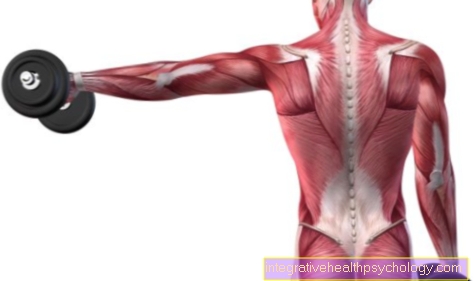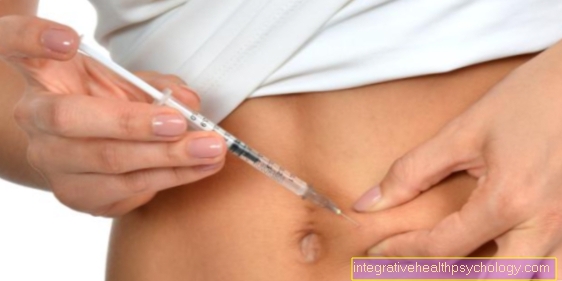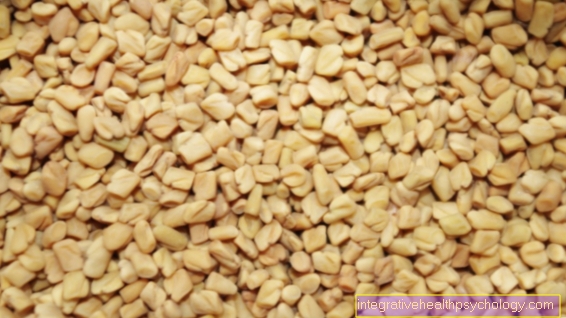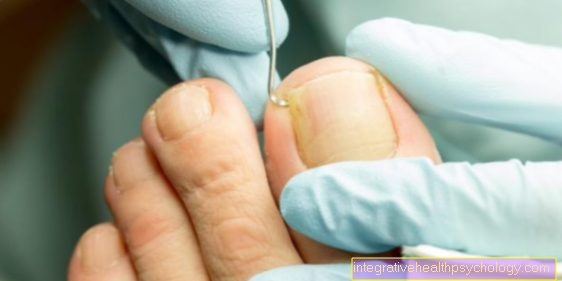Torn muscle fiber of the upper arm
Definition / introduction
A torn muscle fiber on the upper arm is usually a rupture of muscle tissue caused by heavy stress. The injury mechanism of a pulled muscle, a ruptured muscle fiber, and a complete ruptured muscle is the same, only the extent of the muscle damage is different.
In the case of a muscle fiber tear, individual fibers of a muscle bundle tear, but some fibers are still intact, otherwise one would speak of a complete muscle tear.

Causes of a torn muscle fiber in the upper arm
The main reasons for a torn muscle fiber on the upper arm are sudden, jerky movements such as tennis, squash or golf, but also suddenly weight acting on the muscle (e.g. lifting weights, lifting heavy everyday objects, etc.). Excessive strain due to fatigue or excessive strain on the muscles can lead to a torn muscle fiber in the upper arm. Other causes are poor or insufficient warming up or stretching of the arm muscles before intensive arm muscle training, as well as cold or wet conditions (e.g. in rainy weather in autumn / winter) or previous, unhealed injuries to the upper arm muscles.
Read more about the upper arm muscles at: Upper arm muscles.
Torn muscle fiber after a fall
A torn muscle fiber on the upper arm is very often a sports injury. Usually the muscles are overused because the athlete has not warmed up enough, has stretched himself or has simply overestimated himself. But even after a violent fall, various muscle injuries can occur. For example, if you fall on your shoulder or twist your arm while falling, the unnatural position of the limbs can lead to torn muscle fibers. Often it is an accident in which not only the muscles, but also the skeleton were affected.
If the humerus breaks, it can injure the muscle. In some cases, it's not just a torn muscle. If the corresponding forces act on the musculoskeletal system, torn muscle bundles or even a muscle tear can be caused.
The elderly represent a particularly sensitive field of patients. Older patients often fall, in which the long tubular bones, ie the upper arm and thigh bones, are affected. Since the connective tissue, muscles and tendon attachments no longer have their old strength and elasticity, tears or even tears can also occur here.
Signs of a torn muscle fiber
The first signs of a torn muscle fiber are not always clear. Depending on the extent, there is more or less pain. These can also increase over time. The torn muscle fiber in the upper arm is often caused during strength training. If the first pain occurs, which is still bearable for the person concerned, the training is often continued. In most cases, this makes the injury worse and causes more pain.
The pain symptoms are usually the same: onset suddenly, violent and persistent. The pain usually subsides slowly when you are at rest and reappears when you move again. Every position of the arm that strains the muscles is painful - be it tension or stretching. This can be compared with sore muscles, in which pain also occurs when the muscles are exerted. The difference lies in the intensity of the pain and the additional functional impairment that may occur.
Read more on the subject below Symptoms of the hamstring torn
Appointment with a sports orthopedic specialist?

I would be happy to advise you!
Who am I?
My name is dr. Nicolas Gumpert. I am a specialist in orthopedics and the founder of .
Various television programs and print media report regularly about my work. On HR television you can see me every 6 weeks live on "Hallo Hessen".
As a passionate athlete, I have specialized in the treatment of sports diseases for professionals and hobby athletes.
The focus is therefore on diseases of the muscles, tendons and joints.
In order to be able to treat successfully in orthopedics, a thorough examination, diagnosis and a medical history are required.
In our very economic world in particular, there is too little time to thoroughly grasp the complex diseases of orthopedics and thus initiate targeted treatment.
I don't want to join the ranks of "quick knife pullers".
The aim of any treatment is treatment without surgery.
Which therapy achieves the best results in the long term can only be determined after looking at all of the information (Examination, X-ray, ultrasound, MRI, etc.) be assessed.
You can find me in:
- Lumedis - your orthopedic surgeon
Kaiserstrasse 14
60311 Frankfurt am Main
Directly to the online appointment arrangement
Unfortunately, it is currently only possible to make an appointment with private health insurers. I hope for your understanding!
Further information about myself can be found at Dr. Nicolas Gumpert
Diagnosis of a torn muscle fiber
In addition to a detailed questioning of the patient (anamnesis) about the accident and the symptoms, the patient should be clinically examined. The upper arm is carefully inspected and attention is paid to swelling, redness and dents (gaps in the tissue) or bumps. In addition, the doctor should carefully but thoroughly feel the muscles of the upper arm (palpation) and watch out for pain or bruises (hematomas). An ultrasound examination (sonography) of the affected upper arm muscle can also point the way, since in the case of a muscle fiber tear, the tear itself or a swelling in the affected region can be detected. MRI is also considered an advanced imaging option for detecting a torn muscle fiber in the upper arm.
Symptoms and complications of a torn hamstring of the upper arm
The main complaint with a torn muscle fiber in the upper arm is pain. These are described as very strong, pungent, and persistent. Active movement, tension or stretching, or force exertion with the help of the upper arm is hardly possible for the patient. In addition, swelling, contraction of the muscle (recognizable as a dent) or discoloration (hematoma) can occur at the site of the muscle fiber tear. The resulting discoloration is bleeding into the tissue surrounding the affected muscle. In the case of very heavy bleeding, the bruising may be impaired in regression and connective tissue may grow into it. The connective tissue can then transform into scar tissue, which can significantly limit the strength and contraction of the affected muscle. The affected upper arm muscle is then more prone to further injuries.
Another complication that can occur after a muscle fiber rupture in the upper arm is the formation of a capsule (cyst) around the resulting bruise, which, like the connective tissue, can restrict muscle strength and contractility.
Furthermore, if the upper arm is stressed too early, it can lead to chronic inflammation with calcium deposits and subsequent ossification (myositis ossificans), which can also reduce the functionality and strength of the upper arm.
Therapy of a torn muscle fiber on the upper arm

If there is a suspicion of a torn upper arm muscle, the following initial measures should first be carried out according to the PECH rule (break, ice, compression, elevation): The affected upper arm should be cooled as quickly as possible for approx. The cold causes the blood vessels in and around the affected muscle to contract and prevents - by reducing the leakage of blood into the surrounding tissue - the development of complications from large bruises. However, the cooling ice should never be placed directly on the skin due to the risk of frostbite.
Furthermore, the arm should be immobilized with the help of a compression bandage and raised, as this also reduces the flow of blood into the surrounding tissue.
After carrying out the immediate measures, a doctor should be consulted as soon as possible, who can discuss the further procedure and recognize complicated processes.
First of all, strict rest of the upper arm should be observed. In this way, the affected muscle fibers can best regenerate themselves. The spontaneous healing powers are relatively high in the case of a torn muscle fiber in the upper arm. Often, however, supportive measures such as heat therapy, massages or ointments are also perceived as helping and accelerating healing in many patients, but the objective effectiveness of the therapy options mentioned is controversial in specialist circles.
Furthermore, anti-inflammatory and analgesic drugs (e.g. diclofenac) can help to alleviate the pain symptoms.
In the case of a very large torn muscle fiber on the upper arm, which is associated with severe pain and functional disorders, an operation may also be necessary in rare cases, which can limit the damage, but also entail a longer recovery time.
Taping the upper arm
In the meantime, a wide variety of musculoskeletal problems are treated with the help of tapes. These self-adhesive plastic strips are applied to the skin according to a specific system and are intended to shorten the healing process. This means that the upper arm can also be taped if there are problems. After a torn muscle fiber, it is particularly important to immobilize the muscle and relieve it. In order to make it easier to get back to using the muscles or to do muscle training, it may be possible to dispense with complete immobilization, as otherwise the muscle tissue will constantly break down.
Depending on which large muscle the muscle fiber tear is in - whether in the biceps or in the triceps - the kinesio tape must be applied differently. The tape prevents excessive mobility of the injured muscle to a certain extent and stabilizes the corresponding part of the musculoskeletal system. The healing process is thus shortened and the time that the muscle needs to resume its old activities is minimized.
It is still important to give the tissue enough time to regenerate, otherwise the injury may worsen. The tape can be attached professionally and usually for a small fee by a physiotherapist or a semi-skilled doctor (including family doctor) or by a layperson. For the latter, there are various websites that provide video material in which taping is explained step by step.
If, for example, the biceps is affected by the muscle fiber tear, an I-shaped tape is used, which should extend from the crook of the elbow to the shoulder.
The strip is cut from one side to about one sixth of the total length (at 30 cm this is 5 cm), from the other side about four sixths (at 30 cm this is 20 cm). This creates an X in a way.
The arm should be stretched to affix the tape. The part of the tape that is not incised is placed in the crook of the elbow, with the short sides towards the forearm, which are fixed there. The two long strips that were created by the large incision are now glued on the left and right of the biceps muscle in an arched manner so that they frame it.
They should meet and end at the front of the shoulder.The course of the muscle is modeled in this way from its insertion to its origin and the tape has a supportive effect if it has been correctly stuck on.
Read more on this topic at: Taping of torn muscle fibers
Homeopathy for a torn muscle fiber in the upper arm
If there is a torn muscle fiber in the upper arm, an orthopedic surgeon or a sports doctor should always be consulted. In addition to the prescribed therapy, homeopathic treatment can be carried out. This can complete the calming measures of conventional medicine. Various natural remedies are used in the form of compresses, ointments, drops and globules.
Quark wraps or wraps with clay can cause the injured tissue to swell due to their cooling effect. Ointments containing arnica or comfrey are said to have an anti-inflammatory effect and can also be applied. Arnica montana (Bergwohlverleih) can also be taken in drop form. This remedy is said to have decongestant and anti-inflammatory effects. The formation of bruises should also be reduced, which can have a positive influence on the healing process in the event of a torn muscle fiber. Other homeopathic remedies are calendula (Marigold) and Apis mellificia (Honey bee), whose overall effect is similar. The dosage should be individually adjusted to the patient by a competent person.
Read more on this topic at: Homeopathy for torn hamstring
Duration of a muscle fiber tear on the upper arm
Depending on the extent and severity of the muscle fiber tear, the time it takes until complete healing takes place and a full load on the affected muscle is possible again varies considerably. But the early supply including cooling and protection is also of crucial importance for the regeneration time.
If the torn muscle fiber is not too big, the upper arm can often be lightly stressed again a few days after the accident. In the course of the next few weeks, if there is no pain, the intensity of the exercise can be increased further and further.
Starting training before the torn muscle fiber has completely healed usually significantly extends the time it takes to fully resilient. The probability of further, larger cracks is also significantly increased.
The overall healing process takes on average about 3-6 weeks.
After the healing process is complete, no speed sports (e.g. tennis or squash) should be practiced with the affected arm, nor should you train with a lot of weight. Sports with slow and flowing movements, such as Swimming, running and cycling.
Read more on this topic at: Duration of a muscle fiber tear
Prophylaxis of a torn muscle fiber in the upper arm
An important preventive measure to prevent muscle fiber tears on the upper arm is to warm up the upper arm muscles well (at least 15 minutes) in the form of flowing, slow movements. This should especially happen before heavy exertion and intensive training. In addition, after the warm-up phase, the upper arm muscles should experience their maximum load at the beginning of the training, since most muscle fiber tears occur when muscle fatigue begins (30-60 min after the start of training).
Overall, overworked and untrained upper arm muscles tend to torn muscle fibers more often, so you should always train at the individual level and increase the training intensity only slowly.
Prognosis for a torn muscle fiber in the upper arm
The prognosis can vary greatly depending on the extent of the tear and the location on the upper arm, but it is generally good. It usually takes three to six weeks for full healing to occur.





























